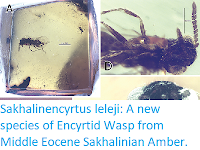Cuckoo Wasps, Chrysididae, are a widespread and diverse group of Wasps, noted for their kleptoparasitic habits; that is to say that, like many Wasps they lay their eggs inside the paralized bodies of other Insects and Arachnids stored in nests, but unlike these Wasps they do not catch their own prey, but rather lay their eggs inside the victims of other parasitic Wasps, the Cuckoo Wasp larvae then eating both the prey and the larvae of the original Wasp. The genus Odontochrydium currently contains three species of Cuckoo Wasps, two from sub-Saharan Africa and one from southern India.
In a paper published in the journal Zootaxa on 18 February 2022, Ahmed Soliman of the Plant Protection Department at King Saud University and the Zoology Department at Al-Azhar University, Paolo Rosa of the Laboratoire de Zoologie at the Université de Mons, and Hathal Dhafer, also of the Plant Protection Department at King Saud University, describe a new species of Odontochrydium from the southern Arabian Peninsula.
The first reported example of a Wasp of the genus Odontochrydium was a female collected from the Asir region of Saudi Arabia in 2015, and identified as a member of the species Odontochrydium bicristatum, which is otherwise known only from East Africa. However, since this report other specimens collected in southern Saudi Arabia, Oman, and Yemen have come to light, including several males (which show greater differentiation between species than is seen in the females), leading Soliman et al. to conclude that the Arabian population is in fact a different species to the East African population.
The new species is named Odontochrydium arabicum, where the specific name 'arabicum' refers to the Arabian Peninsula. The species is described from ten specimens, four males and six females, collected from the Asir and Jazan regions of Saudi Arabia, the Dhofar Governate of Oman, and Yemen.
Males and females of Odontochrydium arabicum are bright green with copper shimmering when alive, but turn a dark metallic blue after death. Both sexes have covering of fine white hairs, and tiny pits. The eyes are also white. Adult Wasps reach about 5.2 mm in length.
See also...



Follow Sciency Thoughts on Facebook.
Follow Sciency Thoughts on Twitter.





